ICT100 Report: 3D Printing Technology in Information Systems Trends
VerifiedAdded on 2023/04/25
|10
|2207
|74
Report
AI Summary
This report provides a comprehensive overview of 3D printing technology, an emerging trend in information systems. It delves into the working principles of 3D printing, highlighting its significance in mechanical and aerospace engineering, along with its strengths such as speed and design freedom, and weaknesses like high energy consumption and material limitations. The report also explores the use of 3D printing in business, particularly in prototyping, and addresses ethical considerations, including piracy and medical applications. The conclusion emphasizes the revolutionary impact of 3D printing on manufacturing and medicine, while acknowledging environmental and ethical challenges that require further research and mitigation strategies. This detailed analysis underscores the potential of 3D printing for innovation and improved product manufacturing.
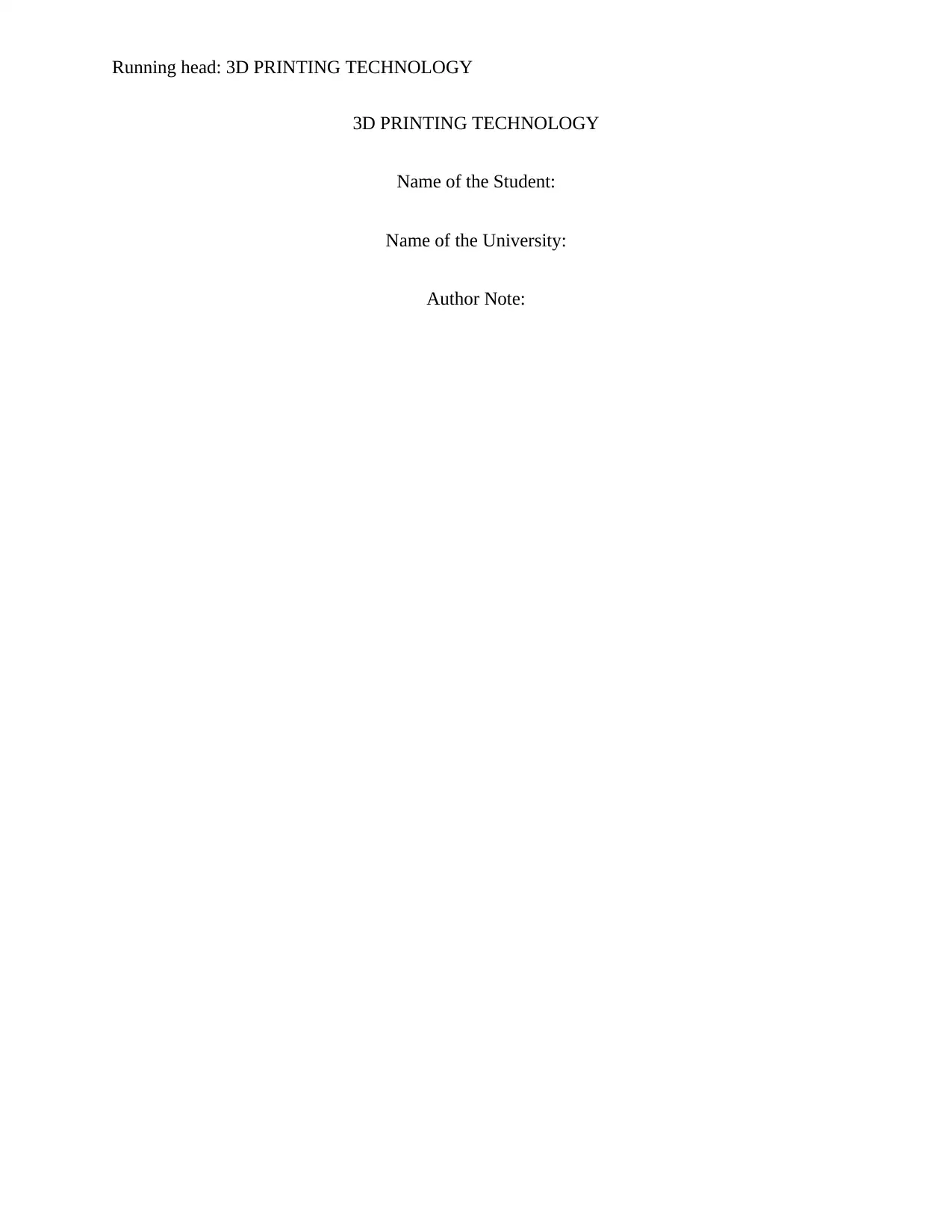
Running head: 3D PRINTING TECHNOLOGY
3D PRINTING TECHNOLOGY
Name of the Student:
Name of the University:
Author Note:
3D PRINTING TECHNOLOGY
Name of the Student:
Name of the University:
Author Note:
Paraphrase This Document
Need a fresh take? Get an instant paraphrase of this document with our AI Paraphraser
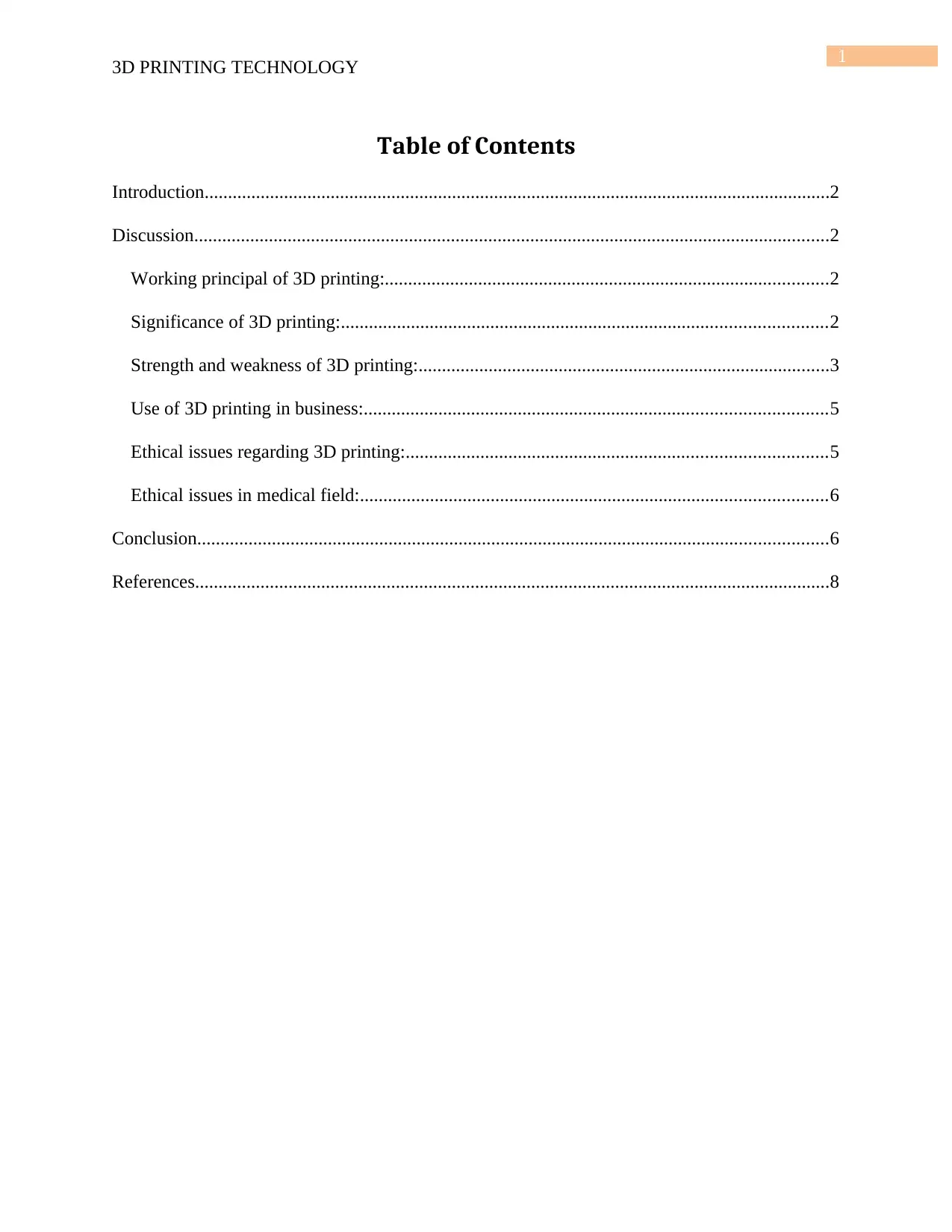
1
3D PRINTING TECHNOLOGY
Table of Contents
Introduction......................................................................................................................................2
Discussion........................................................................................................................................2
Working principal of 3D printing:...............................................................................................2
Significance of 3D printing:........................................................................................................2
Strength and weakness of 3D printing:........................................................................................3
Use of 3D printing in business:...................................................................................................5
Ethical issues regarding 3D printing:..........................................................................................5
Ethical issues in medical field:....................................................................................................6
Conclusion.......................................................................................................................................6
References........................................................................................................................................8
3D PRINTING TECHNOLOGY
Table of Contents
Introduction......................................................................................................................................2
Discussion........................................................................................................................................2
Working principal of 3D printing:...............................................................................................2
Significance of 3D printing:........................................................................................................2
Strength and weakness of 3D printing:........................................................................................3
Use of 3D printing in business:...................................................................................................5
Ethical issues regarding 3D printing:..........................................................................................5
Ethical issues in medical field:....................................................................................................6
Conclusion.......................................................................................................................................6
References........................................................................................................................................8
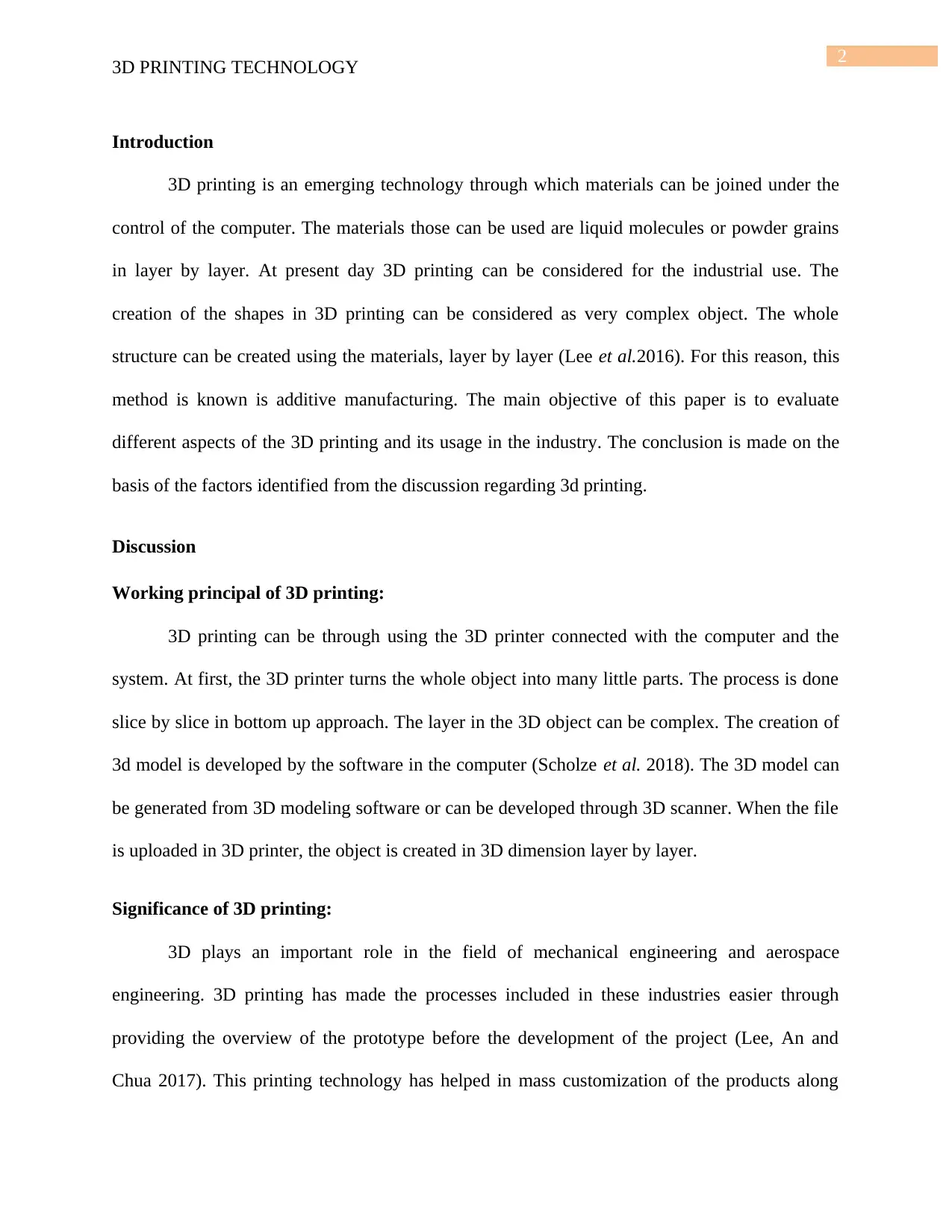
2
3D PRINTING TECHNOLOGY
Introduction
3D printing is an emerging technology through which materials can be joined under the
control of the computer. The materials those can be used are liquid molecules or powder grains
in layer by layer. At present day 3D printing can be considered for the industrial use. The
creation of the shapes in 3D printing can be considered as very complex object. The whole
structure can be created using the materials, layer by layer (Lee et al.2016). For this reason, this
method is known is additive manufacturing. The main objective of this paper is to evaluate
different aspects of the 3D printing and its usage in the industry. The conclusion is made on the
basis of the factors identified from the discussion regarding 3d printing.
Discussion
Working principal of 3D printing:
3D printing can be through using the 3D printer connected with the computer and the
system. At first, the 3D printer turns the whole object into many little parts. The process is done
slice by slice in bottom up approach. The layer in the 3D object can be complex. The creation of
3d model is developed by the software in the computer (Scholze et al. 2018). The 3D model can
be generated from 3D modeling software or can be developed through 3D scanner. When the file
is uploaded in 3D printer, the object is created in 3D dimension layer by layer.
Significance of 3D printing:
3D plays an important role in the field of mechanical engineering and aerospace
engineering. 3D printing has made the processes included in these industries easier through
providing the overview of the prototype before the development of the project (Lee, An and
Chua 2017). This printing technology has helped in mass customization of the products along
3D PRINTING TECHNOLOGY
Introduction
3D printing is an emerging technology through which materials can be joined under the
control of the computer. The materials those can be used are liquid molecules or powder grains
in layer by layer. At present day 3D printing can be considered for the industrial use. The
creation of the shapes in 3D printing can be considered as very complex object. The whole
structure can be created using the materials, layer by layer (Lee et al.2016). For this reason, this
method is known is additive manufacturing. The main objective of this paper is to evaluate
different aspects of the 3D printing and its usage in the industry. The conclusion is made on the
basis of the factors identified from the discussion regarding 3d printing.
Discussion
Working principal of 3D printing:
3D printing can be through using the 3D printer connected with the computer and the
system. At first, the 3D printer turns the whole object into many little parts. The process is done
slice by slice in bottom up approach. The layer in the 3D object can be complex. The creation of
3d model is developed by the software in the computer (Scholze et al. 2018). The 3D model can
be generated from 3D modeling software or can be developed through 3D scanner. When the file
is uploaded in 3D printer, the object is created in 3D dimension layer by layer.
Significance of 3D printing:
3D plays an important role in the field of mechanical engineering and aerospace
engineering. 3D printing has made the processes included in these industries easier through
providing the overview of the prototype before the development of the project (Lee, An and
Chua 2017). This printing technology has helped in mass customization of the products along
⊘ This is a preview!⊘
Do you want full access?
Subscribe today to unlock all pages.

Trusted by 1+ million students worldwide
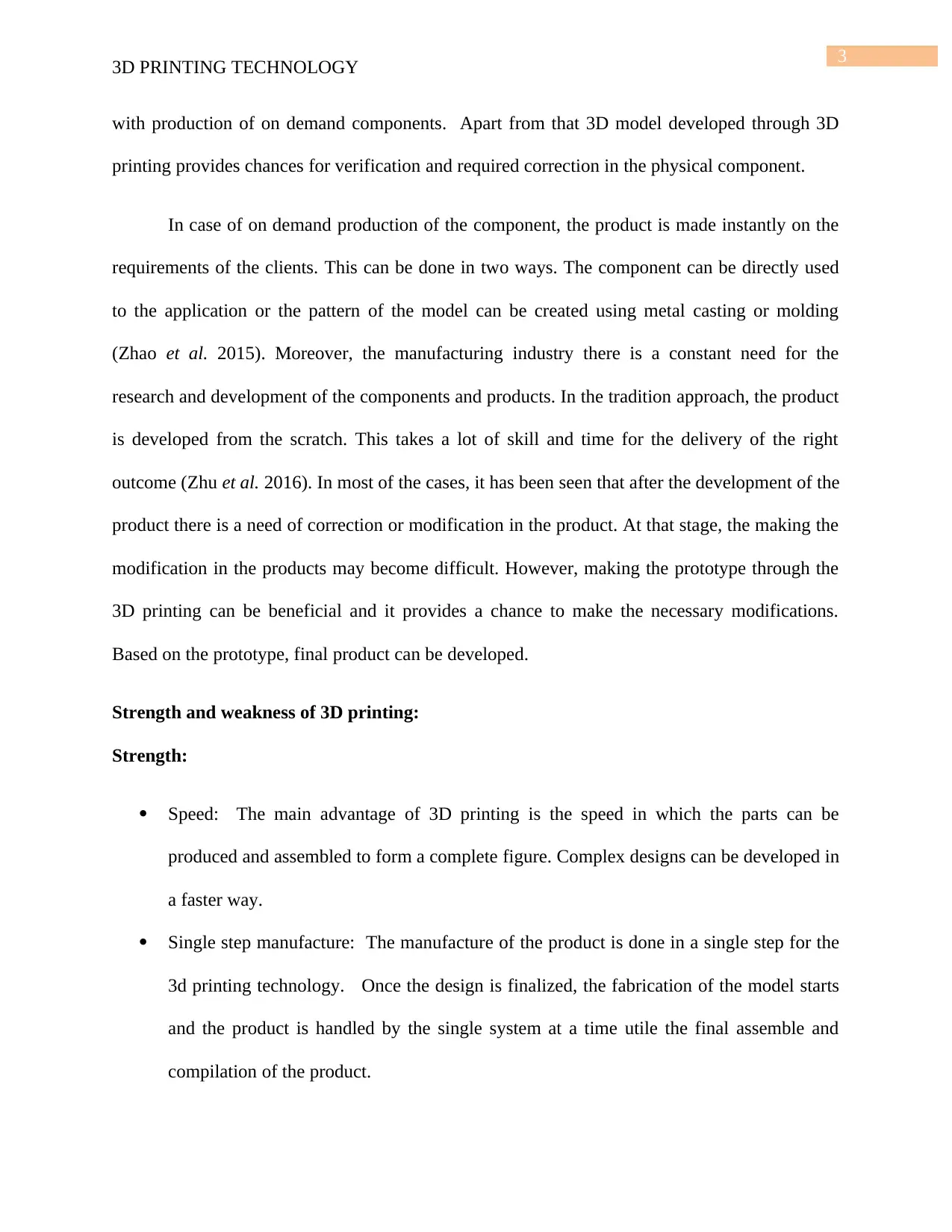
3
3D PRINTING TECHNOLOGY
with production of on demand components. Apart from that 3D model developed through 3D
printing provides chances for verification and required correction in the physical component.
In case of on demand production of the component, the product is made instantly on the
requirements of the clients. This can be done in two ways. The component can be directly used
to the application or the pattern of the model can be created using metal casting or molding
(Zhao et al. 2015). Moreover, the manufacturing industry there is a constant need for the
research and development of the components and products. In the tradition approach, the product
is developed from the scratch. This takes a lot of skill and time for the delivery of the right
outcome (Zhu et al. 2016). In most of the cases, it has been seen that after the development of the
product there is a need of correction or modification in the product. At that stage, the making the
modification in the products may become difficult. However, making the prototype through the
3D printing can be beneficial and it provides a chance to make the necessary modifications.
Based on the prototype, final product can be developed.
Strength and weakness of 3D printing:
Strength:
Speed: The main advantage of 3D printing is the speed in which the parts can be
produced and assembled to form a complete figure. Complex designs can be developed in
a faster way.
Single step manufacture: The manufacture of the product is done in a single step for the
3d printing technology. Once the design is finalized, the fabrication of the model starts
and the product is handled by the single system at a time utile the final assemble and
compilation of the product.
3D PRINTING TECHNOLOGY
with production of on demand components. Apart from that 3D model developed through 3D
printing provides chances for verification and required correction in the physical component.
In case of on demand production of the component, the product is made instantly on the
requirements of the clients. This can be done in two ways. The component can be directly used
to the application or the pattern of the model can be created using metal casting or molding
(Zhao et al. 2015). Moreover, the manufacturing industry there is a constant need for the
research and development of the components and products. In the tradition approach, the product
is developed from the scratch. This takes a lot of skill and time for the delivery of the right
outcome (Zhu et al. 2016). In most of the cases, it has been seen that after the development of the
product there is a need of correction or modification in the product. At that stage, the making the
modification in the products may become difficult. However, making the prototype through the
3D printing can be beneficial and it provides a chance to make the necessary modifications.
Based on the prototype, final product can be developed.
Strength and weakness of 3D printing:
Strength:
Speed: The main advantage of 3D printing is the speed in which the parts can be
produced and assembled to form a complete figure. Complex designs can be developed in
a faster way.
Single step manufacture: The manufacture of the product is done in a single step for the
3d printing technology. Once the design is finalized, the fabrication of the model starts
and the product is handled by the single system at a time utile the final assemble and
compilation of the product.
Paraphrase This Document
Need a fresh take? Get an instant paraphrase of this document with our AI Paraphraser
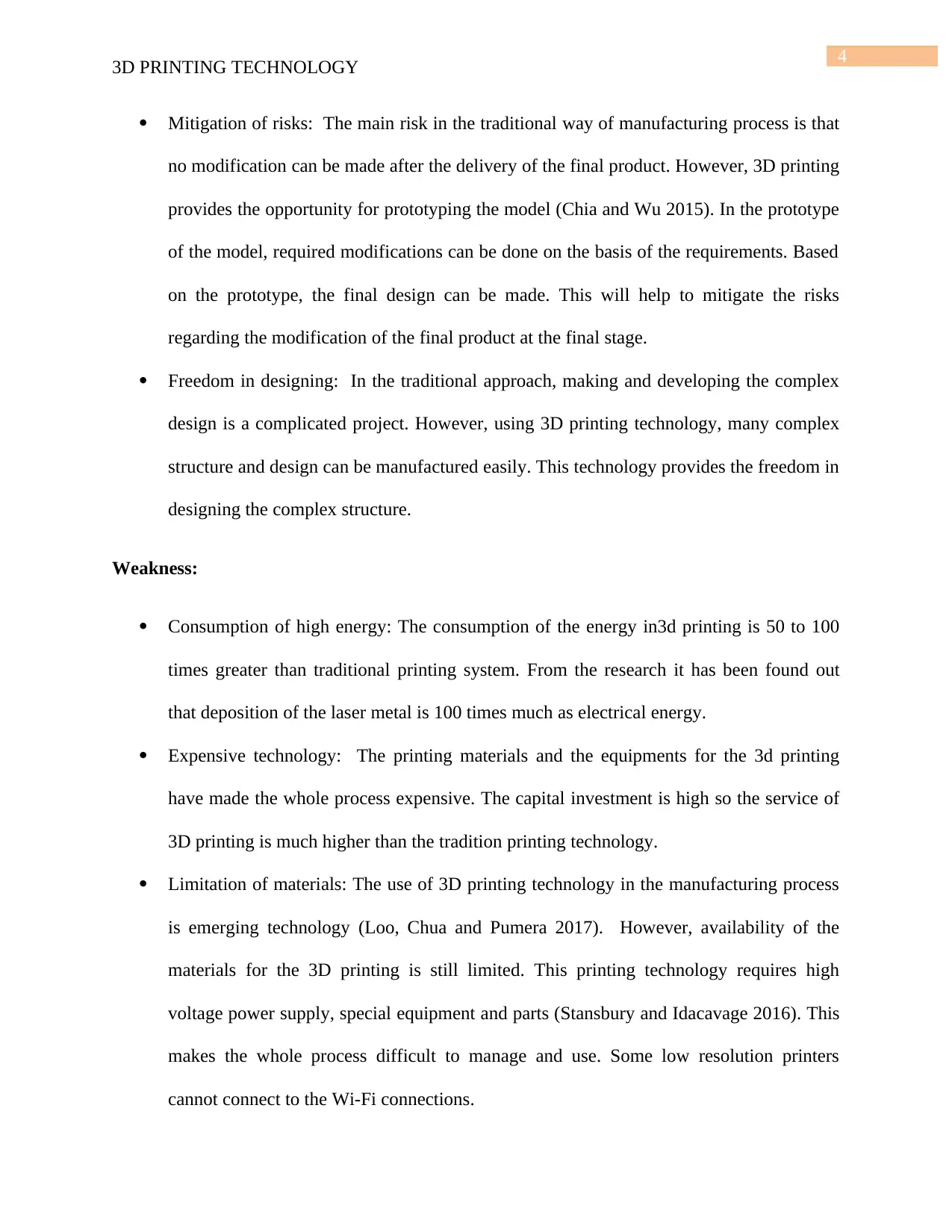
4
3D PRINTING TECHNOLOGY
Mitigation of risks: The main risk in the traditional way of manufacturing process is that
no modification can be made after the delivery of the final product. However, 3D printing
provides the opportunity for prototyping the model (Chia and Wu 2015). In the prototype
of the model, required modifications can be done on the basis of the requirements. Based
on the prototype, the final design can be made. This will help to mitigate the risks
regarding the modification of the final product at the final stage.
Freedom in designing: In the traditional approach, making and developing the complex
design is a complicated project. However, using 3D printing technology, many complex
structure and design can be manufactured easily. This technology provides the freedom in
designing the complex structure.
Weakness:
Consumption of high energy: The consumption of the energy in3d printing is 50 to 100
times greater than traditional printing system. From the research it has been found out
that deposition of the laser metal is 100 times much as electrical energy.
Expensive technology: The printing materials and the equipments for the 3d printing
have made the whole process expensive. The capital investment is high so the service of
3D printing is much higher than the tradition printing technology.
Limitation of materials: The use of 3D printing technology in the manufacturing process
is emerging technology (Loo, Chua and Pumera 2017). However, availability of the
materials for the 3D printing is still limited. This printing technology requires high
voltage power supply, special equipment and parts (Stansbury and Idacavage 2016). This
makes the whole process difficult to manage and use. Some low resolution printers
cannot connect to the Wi-Fi connections.
3D PRINTING TECHNOLOGY
Mitigation of risks: The main risk in the traditional way of manufacturing process is that
no modification can be made after the delivery of the final product. However, 3D printing
provides the opportunity for prototyping the model (Chia and Wu 2015). In the prototype
of the model, required modifications can be done on the basis of the requirements. Based
on the prototype, the final design can be made. This will help to mitigate the risks
regarding the modification of the final product at the final stage.
Freedom in designing: In the traditional approach, making and developing the complex
design is a complicated project. However, using 3D printing technology, many complex
structure and design can be manufactured easily. This technology provides the freedom in
designing the complex structure.
Weakness:
Consumption of high energy: The consumption of the energy in3d printing is 50 to 100
times greater than traditional printing system. From the research it has been found out
that deposition of the laser metal is 100 times much as electrical energy.
Expensive technology: The printing materials and the equipments for the 3d printing
have made the whole process expensive. The capital investment is high so the service of
3D printing is much higher than the tradition printing technology.
Limitation of materials: The use of 3D printing technology in the manufacturing process
is emerging technology (Loo, Chua and Pumera 2017). However, availability of the
materials for the 3D printing is still limited. This printing technology requires high
voltage power supply, special equipment and parts (Stansbury and Idacavage 2016). This
makes the whole process difficult to manage and use. Some low resolution printers
cannot connect to the Wi-Fi connections.
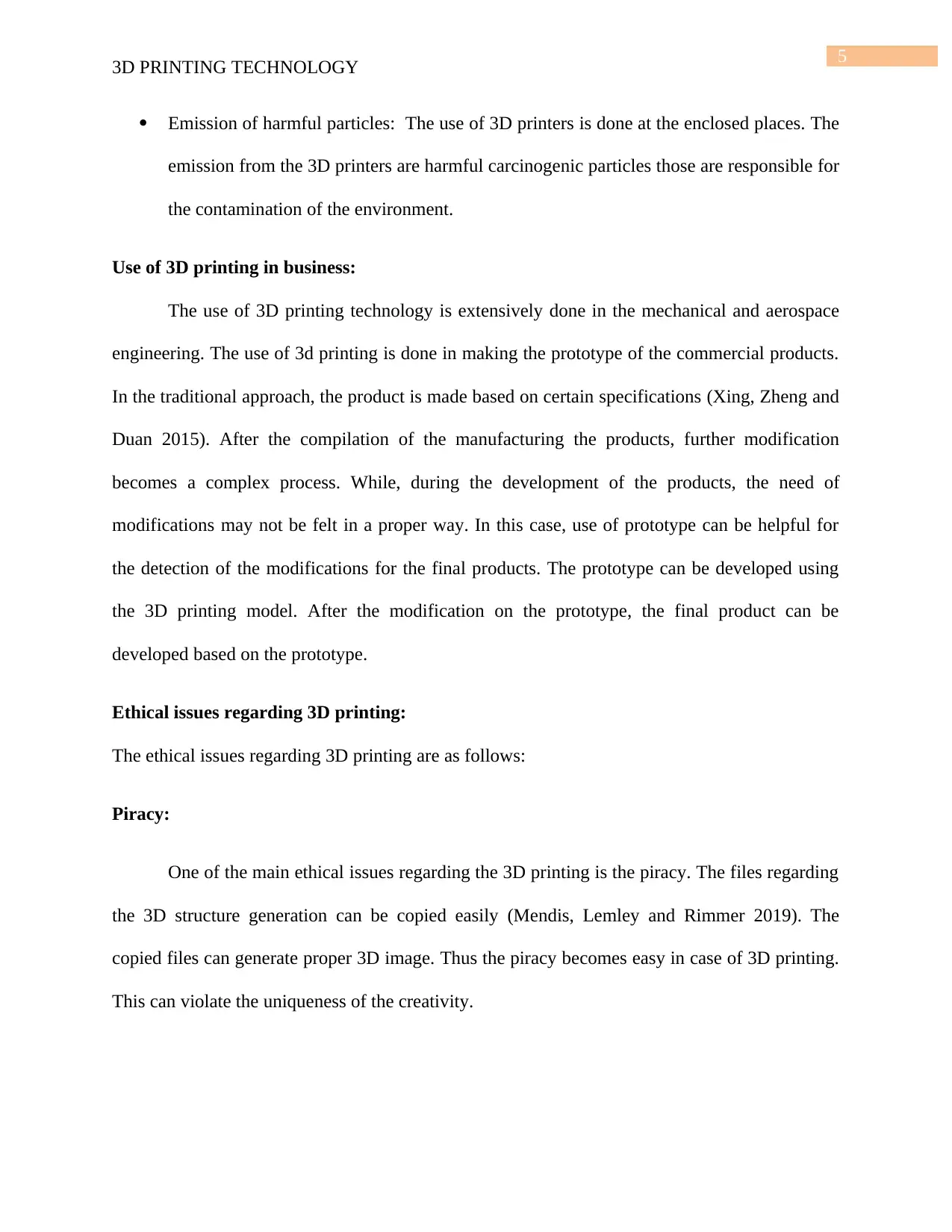
5
3D PRINTING TECHNOLOGY
Emission of harmful particles: The use of 3D printers is done at the enclosed places. The
emission from the 3D printers are harmful carcinogenic particles those are responsible for
the contamination of the environment.
Use of 3D printing in business:
The use of 3D printing technology is extensively done in the mechanical and aerospace
engineering. The use of 3d printing is done in making the prototype of the commercial products.
In the traditional approach, the product is made based on certain specifications (Xing, Zheng and
Duan 2015). After the compilation of the manufacturing the products, further modification
becomes a complex process. While, during the development of the products, the need of
modifications may not be felt in a proper way. In this case, use of prototype can be helpful for
the detection of the modifications for the final products. The prototype can be developed using
the 3D printing model. After the modification on the prototype, the final product can be
developed based on the prototype.
Ethical issues regarding 3D printing:
The ethical issues regarding 3D printing are as follows:
Piracy:
One of the main ethical issues regarding the 3D printing is the piracy. The files regarding
the 3D structure generation can be copied easily (Mendis, Lemley and Rimmer 2019). The
copied files can generate proper 3D image. Thus the piracy becomes easy in case of 3D printing.
This can violate the uniqueness of the creativity.
3D PRINTING TECHNOLOGY
Emission of harmful particles: The use of 3D printers is done at the enclosed places. The
emission from the 3D printers are harmful carcinogenic particles those are responsible for
the contamination of the environment.
Use of 3D printing in business:
The use of 3D printing technology is extensively done in the mechanical and aerospace
engineering. The use of 3d printing is done in making the prototype of the commercial products.
In the traditional approach, the product is made based on certain specifications (Xing, Zheng and
Duan 2015). After the compilation of the manufacturing the products, further modification
becomes a complex process. While, during the development of the products, the need of
modifications may not be felt in a proper way. In this case, use of prototype can be helpful for
the detection of the modifications for the final products. The prototype can be developed using
the 3D printing model. After the modification on the prototype, the final product can be
developed based on the prototype.
Ethical issues regarding 3D printing:
The ethical issues regarding 3D printing are as follows:
Piracy:
One of the main ethical issues regarding the 3D printing is the piracy. The files regarding
the 3D structure generation can be copied easily (Mendis, Lemley and Rimmer 2019). The
copied files can generate proper 3D image. Thus the piracy becomes easy in case of 3D printing.
This can violate the uniqueness of the creativity.
⊘ This is a preview!⊘
Do you want full access?
Subscribe today to unlock all pages.

Trusted by 1+ million students worldwide
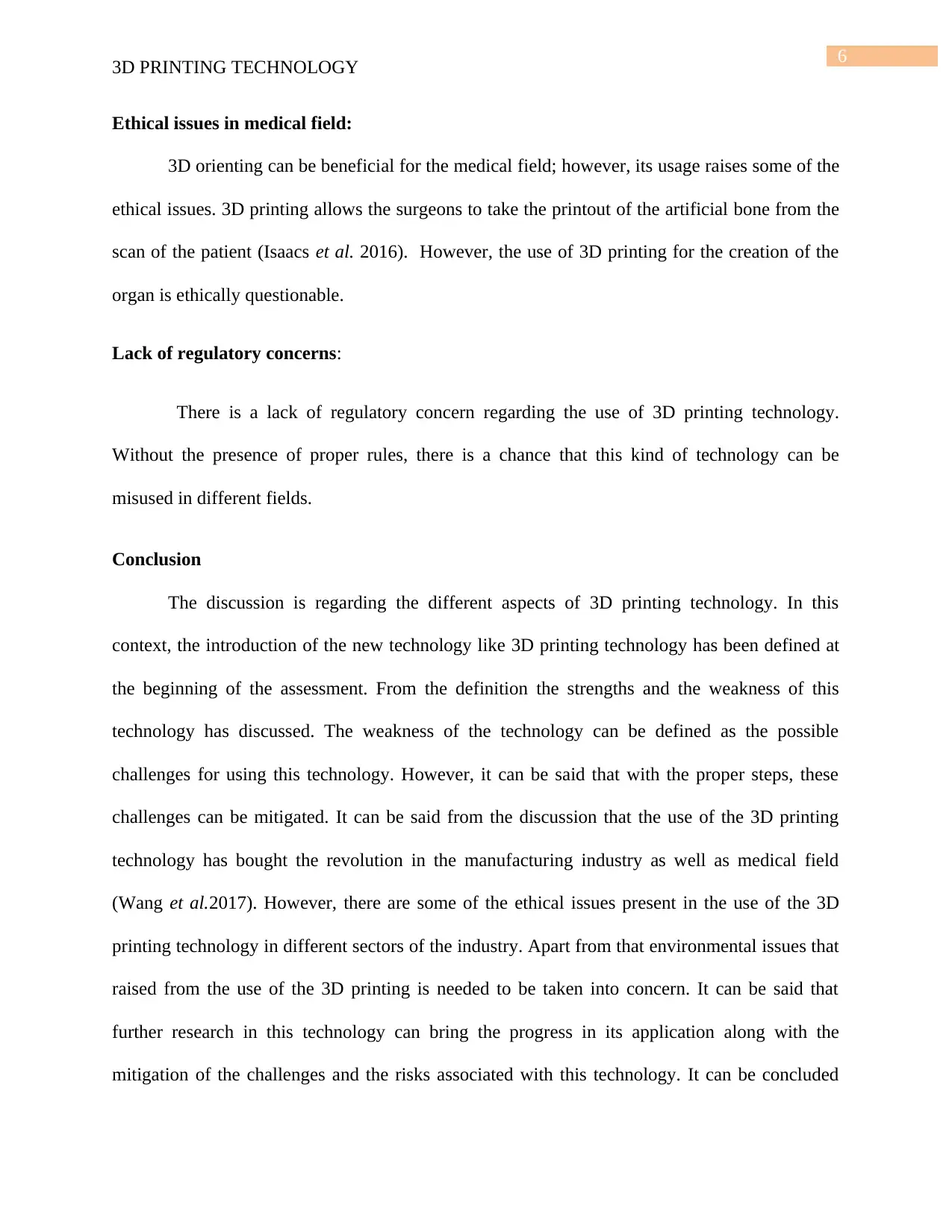
6
3D PRINTING TECHNOLOGY
Ethical issues in medical field:
3D orienting can be beneficial for the medical field; however, its usage raises some of the
ethical issues. 3D printing allows the surgeons to take the printout of the artificial bone from the
scan of the patient (Isaacs et al. 2016). However, the use of 3D printing for the creation of the
organ is ethically questionable.
Lack of regulatory concerns:
There is a lack of regulatory concern regarding the use of 3D printing technology.
Without the presence of proper rules, there is a chance that this kind of technology can be
misused in different fields.
Conclusion
The discussion is regarding the different aspects of 3D printing technology. In this
context, the introduction of the new technology like 3D printing technology has been defined at
the beginning of the assessment. From the definition the strengths and the weakness of this
technology has discussed. The weakness of the technology can be defined as the possible
challenges for using this technology. However, it can be said that with the proper steps, these
challenges can be mitigated. It can be said from the discussion that the use of the 3D printing
technology has bought the revolution in the manufacturing industry as well as medical field
(Wang et al.2017). However, there are some of the ethical issues present in the use of the 3D
printing technology in different sectors of the industry. Apart from that environmental issues that
raised from the use of the 3D printing is needed to be taken into concern. It can be said that
further research in this technology can bring the progress in its application along with the
mitigation of the challenges and the risks associated with this technology. It can be concluded
3D PRINTING TECHNOLOGY
Ethical issues in medical field:
3D orienting can be beneficial for the medical field; however, its usage raises some of the
ethical issues. 3D printing allows the surgeons to take the printout of the artificial bone from the
scan of the patient (Isaacs et al. 2016). However, the use of 3D printing for the creation of the
organ is ethically questionable.
Lack of regulatory concerns:
There is a lack of regulatory concern regarding the use of 3D printing technology.
Without the presence of proper rules, there is a chance that this kind of technology can be
misused in different fields.
Conclusion
The discussion is regarding the different aspects of 3D printing technology. In this
context, the introduction of the new technology like 3D printing technology has been defined at
the beginning of the assessment. From the definition the strengths and the weakness of this
technology has discussed. The weakness of the technology can be defined as the possible
challenges for using this technology. However, it can be said that with the proper steps, these
challenges can be mitigated. It can be said from the discussion that the use of the 3D printing
technology has bought the revolution in the manufacturing industry as well as medical field
(Wang et al.2017). However, there are some of the ethical issues present in the use of the 3D
printing technology in different sectors of the industry. Apart from that environmental issues that
raised from the use of the 3D printing is needed to be taken into concern. It can be said that
further research in this technology can bring the progress in its application along with the
mitigation of the challenges and the risks associated with this technology. It can be concluded
Paraphrase This Document
Need a fresh take? Get an instant paraphrase of this document with our AI Paraphraser

7
3D PRINTING TECHNOLOGY
from the above discussion that the use of the 3D printing technology is helpful for the innovation
of the new designs and better manufacturing of the products.
3D PRINTING TECHNOLOGY
from the above discussion that the use of the 3D printing technology is helpful for the innovation
of the new designs and better manufacturing of the products.
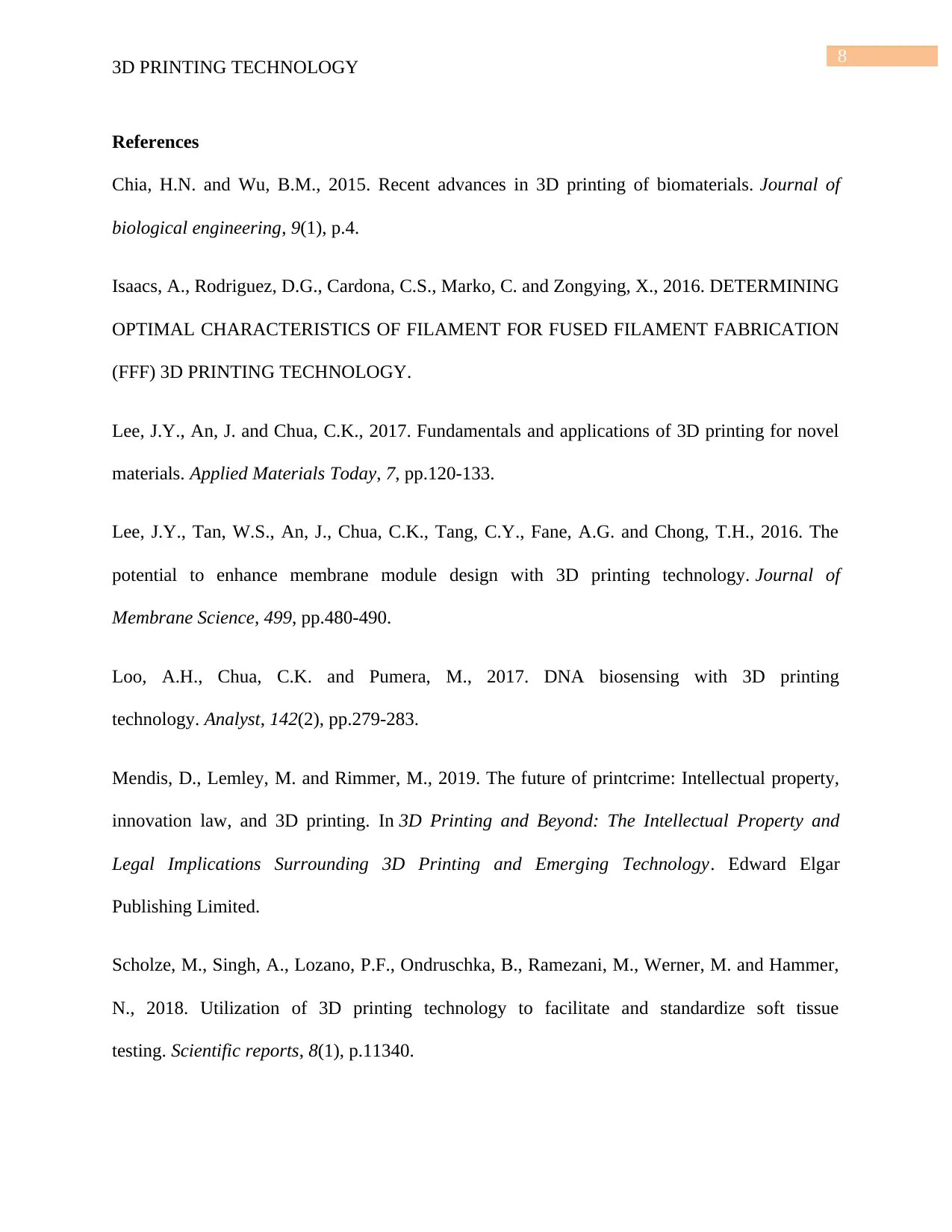
8
3D PRINTING TECHNOLOGY
References
Chia, H.N. and Wu, B.M., 2015. Recent advances in 3D printing of biomaterials. Journal of
biological engineering, 9(1), p.4.
Isaacs, A., Rodriguez, D.G., Cardona, C.S., Marko, C. and Zongying, X., 2016. DETERMINING
OPTIMAL CHARACTERISTICS OF FILAMENT FOR FUSED FILAMENT FABRICATION
(FFF) 3D PRINTING TECHNOLOGY.
Lee, J.Y., An, J. and Chua, C.K., 2017. Fundamentals and applications of 3D printing for novel
materials. Applied Materials Today, 7, pp.120-133.
Lee, J.Y., Tan, W.S., An, J., Chua, C.K., Tang, C.Y., Fane, A.G. and Chong, T.H., 2016. The
potential to enhance membrane module design with 3D printing technology. Journal of
Membrane Science, 499, pp.480-490.
Loo, A.H., Chua, C.K. and Pumera, M., 2017. DNA biosensing with 3D printing
technology. Analyst, 142(2), pp.279-283.
Mendis, D., Lemley, M. and Rimmer, M., 2019. The future of printcrime: Intellectual property,
innovation law, and 3D printing. In 3D Printing and Beyond: The Intellectual Property and
Legal Implications Surrounding 3D Printing and Emerging Technology. Edward Elgar
Publishing Limited.
Scholze, M., Singh, A., Lozano, P.F., Ondruschka, B., Ramezani, M., Werner, M. and Hammer,
N., 2018. Utilization of 3D printing technology to facilitate and standardize soft tissue
testing. Scientific reports, 8(1), p.11340.
3D PRINTING TECHNOLOGY
References
Chia, H.N. and Wu, B.M., 2015. Recent advances in 3D printing of biomaterials. Journal of
biological engineering, 9(1), p.4.
Isaacs, A., Rodriguez, D.G., Cardona, C.S., Marko, C. and Zongying, X., 2016. DETERMINING
OPTIMAL CHARACTERISTICS OF FILAMENT FOR FUSED FILAMENT FABRICATION
(FFF) 3D PRINTING TECHNOLOGY.
Lee, J.Y., An, J. and Chua, C.K., 2017. Fundamentals and applications of 3D printing for novel
materials. Applied Materials Today, 7, pp.120-133.
Lee, J.Y., Tan, W.S., An, J., Chua, C.K., Tang, C.Y., Fane, A.G. and Chong, T.H., 2016. The
potential to enhance membrane module design with 3D printing technology. Journal of
Membrane Science, 499, pp.480-490.
Loo, A.H., Chua, C.K. and Pumera, M., 2017. DNA biosensing with 3D printing
technology. Analyst, 142(2), pp.279-283.
Mendis, D., Lemley, M. and Rimmer, M., 2019. The future of printcrime: Intellectual property,
innovation law, and 3D printing. In 3D Printing and Beyond: The Intellectual Property and
Legal Implications Surrounding 3D Printing and Emerging Technology. Edward Elgar
Publishing Limited.
Scholze, M., Singh, A., Lozano, P.F., Ondruschka, B., Ramezani, M., Werner, M. and Hammer,
N., 2018. Utilization of 3D printing technology to facilitate and standardize soft tissue
testing. Scientific reports, 8(1), p.11340.
⊘ This is a preview!⊘
Do you want full access?
Subscribe today to unlock all pages.

Trusted by 1+ million students worldwide
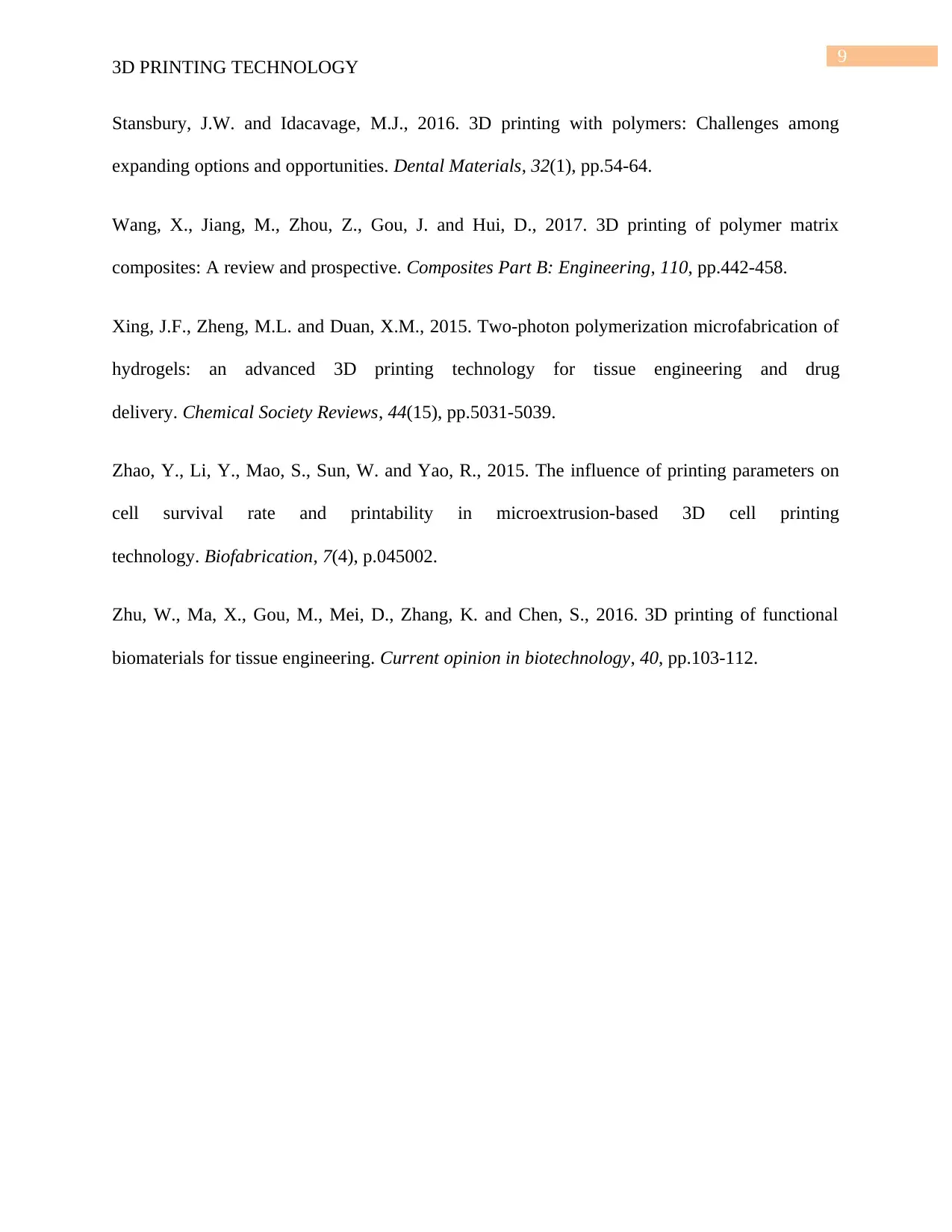
9
3D PRINTING TECHNOLOGY
Stansbury, J.W. and Idacavage, M.J., 2016. 3D printing with polymers: Challenges among
expanding options and opportunities. Dental Materials, 32(1), pp.54-64.
Wang, X., Jiang, M., Zhou, Z., Gou, J. and Hui, D., 2017. 3D printing of polymer matrix
composites: A review and prospective. Composites Part B: Engineering, 110, pp.442-458.
Xing, J.F., Zheng, M.L. and Duan, X.M., 2015. Two-photon polymerization microfabrication of
hydrogels: an advanced 3D printing technology for tissue engineering and drug
delivery. Chemical Society Reviews, 44(15), pp.5031-5039.
Zhao, Y., Li, Y., Mao, S., Sun, W. and Yao, R., 2015. The influence of printing parameters on
cell survival rate and printability in microextrusion-based 3D cell printing
technology. Biofabrication, 7(4), p.045002.
Zhu, W., Ma, X., Gou, M., Mei, D., Zhang, K. and Chen, S., 2016. 3D printing of functional
biomaterials for tissue engineering. Current opinion in biotechnology, 40, pp.103-112.
3D PRINTING TECHNOLOGY
Stansbury, J.W. and Idacavage, M.J., 2016. 3D printing with polymers: Challenges among
expanding options and opportunities. Dental Materials, 32(1), pp.54-64.
Wang, X., Jiang, M., Zhou, Z., Gou, J. and Hui, D., 2017. 3D printing of polymer matrix
composites: A review and prospective. Composites Part B: Engineering, 110, pp.442-458.
Xing, J.F., Zheng, M.L. and Duan, X.M., 2015. Two-photon polymerization microfabrication of
hydrogels: an advanced 3D printing technology for tissue engineering and drug
delivery. Chemical Society Reviews, 44(15), pp.5031-5039.
Zhao, Y., Li, Y., Mao, S., Sun, W. and Yao, R., 2015. The influence of printing parameters on
cell survival rate and printability in microextrusion-based 3D cell printing
technology. Biofabrication, 7(4), p.045002.
Zhu, W., Ma, X., Gou, M., Mei, D., Zhang, K. and Chen, S., 2016. 3D printing of functional
biomaterials for tissue engineering. Current opinion in biotechnology, 40, pp.103-112.
1 out of 10
Related Documents
Your All-in-One AI-Powered Toolkit for Academic Success.
+13062052269
info@desklib.com
Available 24*7 on WhatsApp / Email
![[object Object]](/_next/static/media/star-bottom.7253800d.svg)
Unlock your academic potential
Copyright © 2020–2025 A2Z Services. All Rights Reserved. Developed and managed by ZUCOL.





